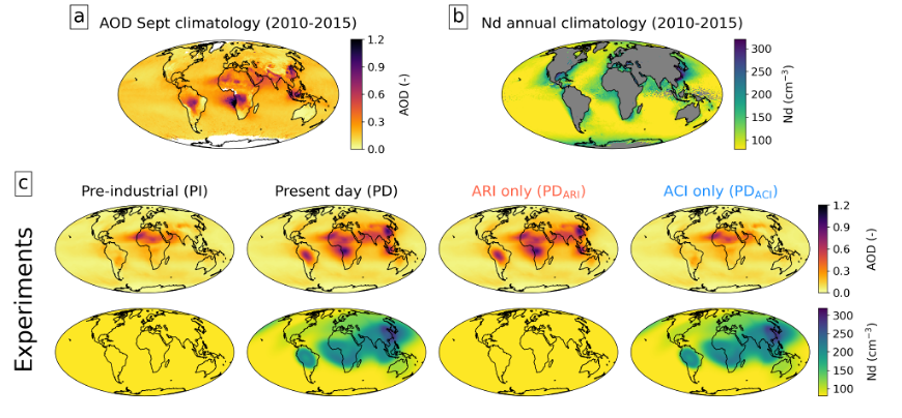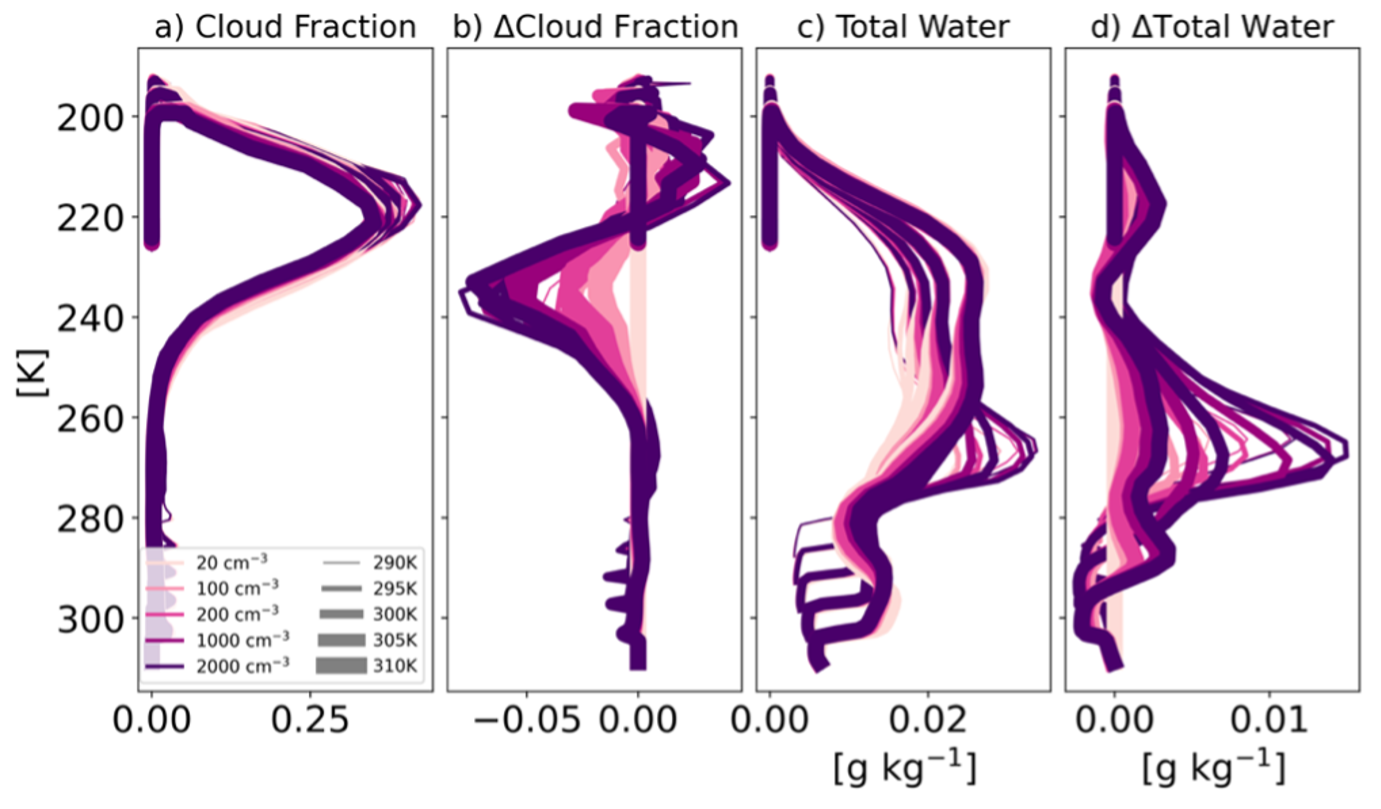The GEWEX Aerosol Precipitation initiative
Contact: Philip Stier (University of Oxford), Sue van den Heever (Colorado State University), Guy Dagan (Hebrew University of Jerusalem)
Precipitation is of fundamental importance for all life on Earth. A significant body of research exists on the impact of greenhouse gas-induced global warming on precipitation. Beyond greenhouse gas effects, aerosols have been hypothesized to have a wide range of effects on precipitation, through i) radiative effects via modification of radiative fluxes and the energy balance and ii) microphysical effects via modification of the properties and processes associated with cloud droplets and ice crystals.
While it is widely recognized that aerosols could exert a significant impact on precipitation – in fact, the largest recorded decrease in global mean precipitation followed the injection of volcanic aerosol from the Mount Pinatubo volcanic eruption – evidence for systematic aerosol effects on regional and global precipitation remains ambiguous. This limited progress can be attributed, in part, to the prevailing gap between local process-driven approaches, such as those utilized in the Aerosol, Clouds, Precipitation and Climate (ACPC) initiative, and the more global perspectives of climate modelling and satellite studies.
Aims
The GEWEX Aerosol Precipitation (GAP) initiative aims to close this gap, with the goals to:
- enhance our understanding of aerosol-precipitation interactions on a regional to global scale with a focus on energy and water budget constraints
- facilitate connections between all GEWEX and related process-based activities focusing on cloud-aerosol-precipitation interactions, such as ACPC.
Opportunities
Significant opportunities now exist that allow us to capitalize on recent advances to make progress in this area: a large body of literature now underpins our theoretical understanding of aerosol effects on cloud microphysics and precipitation formation processes as well as the convective momentum budget [Marinescu et al., 2021] and on how energy and water budget constraints can be applied to understand aerosol effects on precipitation [Dagan et al., 2019; Dagan and Stier, 2020; Dagan et al., 2021]. Novel earth observations from geostationary satellites and fleets of active and passive remote sensing instruments will allow to constrain global cloud lifecycles as well as cloud microphysics and dynamics, and global km-scale atmospheric models are now available to overcome the structural limitations associated with the representation of clouds in traditional CMIP style climate models.
GAP Activities
GAP’s initial strategy was guided and refined through two initial expert workshops:
- Expert workshop on aerosol effects on precipitation
A general expert workshop on aerosol effects on precipitation was held in Oxford in 2017, and summarized in a review paper:
Multifaceted aerosol effects on precipitation, Stier, P., S. C. van den Heever, M. Christensen, E. Gryspeerdt, G. Dagan, M. Bollasina, L. Donner, K. Emanuel, A. M. L. Ekman, G. Feingold, P. Field, P. Forster, J. Haywood, R. Kahn, I. Koren, C. Kummerow, T. L’Ecuyer, U. Lohmann, Y. Ming, G. Myhre, J. Quaas, D. Rosenfeld, B. Samset, A. Seifert, G. Stephens, and W.-K. Tao (in review). - Expert workshop on the observational evidence for aerosol effects on precipitation
The first GAP expert workshop was followed up by a more targeted workshop to assess the observational evidence for aerosol effects on precipitation, held in Oxford in 2019, and summarized in a review paper:
Observational evidence for aerosol effects on precipitation, Gryspeerdt, E., M. Christensen, J. Muelmenstaedt, T. L’Ecuyer, P. Stier, S. C. van den Heever, A. Gettelman, G. Stephens, I. Koren, J. Quaas, K. Suzuki, and R. Wood (in preparation).
Guided by these expert workshops, we initially propose two initiatives concentrating on exploiting the opportunities provided by the advent of global km-scale atmospheric models to consistently simulate aerosol effects on clouds and precipitation across cloud regimes, including convection. This work will inevitably highlight the need for novel observational constraints on aerosol effects on precipitation at the km-scale, to be developed in subsequent GAP initiatives.
- GAP global km-scale model intercomparison of aerosol effects on precipitation (DYAMOND-GAP?)
The GAP global km-scale model intercomparison of aerosol effects on precipitation will focus on the response of cloud, precipitation and climate to a well-defined prescribed radiative and microphysical aerosol perturbation that can be easily and consistently implemented in all participating km-scale atmospheric models. In this setup, prescribed anthropogenic aerosol perturbations of aerosol optical depth (top row) and cloud droplet numbers (bottom row), based on the MACv2-SP aerosol plume model [Stevens et al., 2017] with modifications as described in Herbert et al. (2021), are superimposed on the natural base state of the participating km-scale models, as demonstrated for ICON-Saphire [Hohenegger et al., 2022] in Figure 1.
 Figure 1: Climatologies of a) MODIS AOD500nm during September (2010–2015), and b) annual mean cloud droplet number concentration (Nd) over the ocean from [Grosvenor et al., 2018]. C) Idealised prescribed anthropogenic aerosol perturbations of aerosol optical depth (top row) and cloud droplet numbers (bottom row), based on the MACv2-SP aerosol plume model with modifications as described in Herbert et al. [2021]: preindustrial baseline with natural aerosol optical depth and constant Nd (PD), including anthropogenic AOD and Nd perturbations (PD), including only anthropogenic AOD perturbations (PDARI), including only anthropogenic Nd perturbations (PDACI).
Figure 1: Climatologies of a) MODIS AOD500nm during September (2010–2015), and b) annual mean cloud droplet number concentration (Nd) over the ocean from [Grosvenor et al., 2018]. C) Idealised prescribed anthropogenic aerosol perturbations of aerosol optical depth (top row) and cloud droplet numbers (bottom row), based on the MACv2-SP aerosol plume model with modifications as described in Herbert et al. [2021]: preindustrial baseline with natural aerosol optical depth and constant Nd (PD), including anthropogenic AOD and Nd perturbations (PD), including only anthropogenic AOD perturbations (PDARI), including only anthropogenic Nd perturbations (PDACI).While this setup ignores potentially important feedbacks of clouds and precipitation on aerosols, it allows us to consistently assess the cloud and precipitation response to a well-defined aerosol perturbation. It further facilitates decomposition of the response to radiative and microphysical perturbations, an approach that has been successfully demonstrated in large domain cloud resolving km-scale simulations over the Amazon [Herbert et al., 2021]. The simulation protocol will be closely aligned with the upcoming DYAMOND3 intercomparison and will be published on this webpage in autumn 2023.
- GAP Radiative Convective Equilibrium (RCE) model intercomparison project (RCEMIP) aerosol perturbation experiment
An aerosol-focused RCEMIP perturbation experiment is planned for the near future. The RCE setup is ideal for comparing the response of clouds to aerosol perturbation under wide environmental (SST) conditions, focusing on the equilibrium state (as opposed to the transient conditions simulated in DYAMOND-GAP). This setup will be used to examine the sensitivity of the RCE climate, cloud feedback, precipitation efficiency and convective aggregation to the based state of assumed aerosol/cloud droplet concentration. Results from SAM simulations following the RCE_small configuration (from the RCEMIP protocol [Wing et al., 2018]) with 5 different levels of aerosol concentrations and under 5 different SSTs are presented below. It demonstrates that, for a given SST, aerosol concentration affects the anvil cloud fraction and the liquid water in the clouds (Figure 2).
 Figure 2: Vertical profiles of the cloud fraction (a) and total water in clouds © for SAM RCE simulations conducted under different SSTs and aerosol concentrations. Panels (b) and (d), respectively, present the vertical profiles of the response of the cloud fraction and total water to aerosol concentration (compared to the lowest aerosol concentration for each SST).
Figure 2: Vertical profiles of the cloud fraction (a) and total water in clouds © for SAM RCE simulations conducted under different SSTs and aerosol concentrations. Panels (b) and (d), respectively, present the vertical profiles of the response of the cloud fraction and total water to aerosol concentration (compared to the lowest aerosol concentration for each SST).- The simulation protocol will be closely aligned with the RCEMIP protocol but with at least three different prescribed aerosol/ cloud droplet concentrations (near surface concentrations of 20, 200 and 2000 cm3). The aerosol concentrations should affect only the cloud microphysics, and not the radiation directly (as aerosol-radiation interactions are excluded. The simulation protocol will be published on this webpage in autumn 2023.
References

